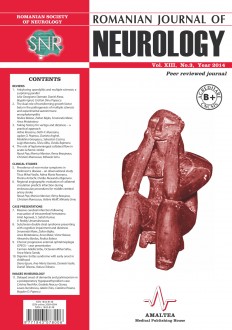SELECT ISSUE

Indexed

| |

|
|
|
| |
|
|
|

|
|
|
|
|
|
| |
|
|
HIGHLIGHTS
National Awards “Science and Research”
NEW! RJN has announced the annually National Award for "Science and Research" for the best scientific articles published throughout the year in the official journal.
Read the Recommendations for the Conduct, Reporting, Editing, and Publication of Scholarly work in Medical Journals.
The published medical research literature is a global public good. Medical journal editors have a social responsibility to promote global health by publishing, whenever possible, research that furthers health worldwide.
DELAYED ONSET OF DEMENTIA AND PARKINSONISM IN A POSTOPERATORY HYPOPARATHYROIDISM CASE
Cristina Nechifor, Gratiela Neacsu-Giurea, Laura Dumitrescu, Adela Chiru, Cătălina POIANĂ and Bogdan O. Popescu
ABSTRACT
Introduction. Brain imaging is mandatory for dementia diagnosis. In various guidelines and clinical studies MRI stands as the first choice, with the highest sensitivity and specificity. Our goal here is to show the exception to the rule. CT remains an imaging method important for diagnosis of pathology characterised by basal ganglia calcifications.
Case history. A female patient,aged 60 years, came to the hospital with symptoms of mild cognitive impairment and parkinsonian syndrome. A medical history of hypertension and total thyroidectomy were recorded. The first imaging option for patient was to perform a brain MRI, which did not bring any information about the cause of dementia. Fortunately a CT was performed as well and bilateral basal ganglia massive calcifications were seen, which were due to total thyroidectomy/parathyroidectomy in the past.
Conclusion. To diagnose secondary congnitive disorders of basal ganglia calcifications a standard head CT seems to be the method of choice.
Keywords: dementia, Parkinson disease, brain imaging
Full text | PDF
